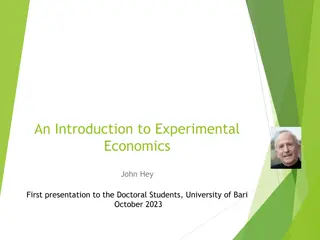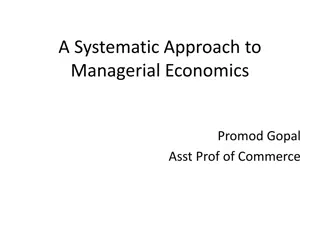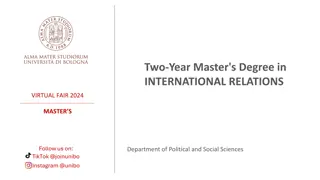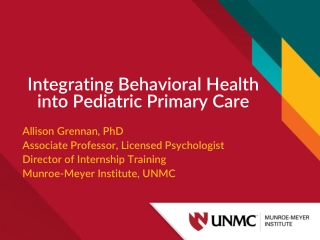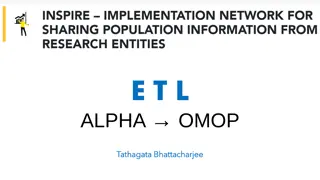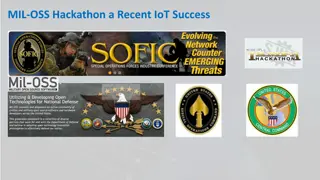Best Practices for Integrating AI into Economics and Business Curricula
Learn how AI is revolutionizing the business world and why it's important for students to have a comprehensive understanding of AI concepts and methodologies. Explore the integration of AI into economics and business education.
Download Presentation

Please find below an Image/Link to download the presentation.
The content on the website is provided AS IS for your information and personal use only. It may not be sold, licensed, or shared on other websites without obtaining consent from the author. Download presentation by click this link. If you encounter any issues during the download, it is possible that the publisher has removed the file from their server.
E N D
Presentation Transcript
Best Practices for Responsibly Integrating AI into Economics and Business Curricula PRESENTERS: Dr. Fariss Mousa, Tatjana Titareva College of Business
Introduction World Economic Forum held in Davos, Switzerland in 2016, Modern society is not facing a technological crisis but instead encountering a significant technological revolution revolution. The magnitude of technological transformations and advancements we are witnessing is unprecedented in the history of humanity unprecedented in the history of humanity (Barnato, 2016). technological McKinsey Global Institute projected that by 2030, approximately 70% of companies will integrate some form of AI technology will integrate some form of AI technology into their operations. Additionally, 60% of job roles may be automated roles may be automated within the next decade (Bughin et al., 2018). companies job Considering this trend, organizations will seek business school graduates with knowledge and expertise in AI concepts and methodologies knowledge and expertise in AI concepts and methodologies, empowering them to effectively manage work environments where AI plays a significant role (Ransbotham et al., 2017). graduates with
AI Integration into Business and Economics Education University system [20thcentury], evolved during an era when industrial needs primarily drove the global economy. With its regimented schedules, standardized curricula, and emphasis on memorization, this education model was purposefully designed to mold students into disciplined and efficient employees, suitable for the predictable and structured environments disciplined and efficient employees, suitable for the predictable and structured environments of factories and traditional corporate settings. Incorporating AI into business curricula is not a voluntary option but a critical need. The acquisition of 21st 21st- -century skil century skills, including a comprehensive understanding of AI progressively becoming more crucial for students (Alshare and Sewailem, 2018). comprehensive understanding of AI, is AI revolution in education influences not only what is learned, but how it is learned , in general and economics and business education specifically (Bandera et al., 2019). With the increasing prominence of artificial intelligence (AI) as a critical catalyst for industrial advancements, numerous business schools numerous business schools (mainly the graduate level and executive education) are incorporating AI into their curricula incorporating AI into their curricula.
Servant Administrative Leadership Dierendonck (2011): servant being being of of team team members providing clear direction. It places particular emphasis on the development followers followers. servant leadership leadership (SL) prioritizes the growth members through humility, authenticity, and stewardship while growth and well well- - development of of Administrative Administrative leadership operations (Hendrickson et al., 2013); Smith, 2015), as well as the unique challenges they face in creating consensus, especially during dramatic change times like post-ChatGPT Era. These leaders have to navigate complex organizational landscapes that often blend various dynamics collegial, collegial, political, political, and and symbolic symbolic across different departmental subcultures (Manning, 2018; Selznick; 2020; Selznick & Titareva, 2022). leadership makes sure that educational systems continue their dynamics bureaucratic, bureaucratic,
Framework Using Servant Administrative Leadership Components for Integrating AI into Economics and Business Curricula
1. Vision and Strategic Direction 6. 2. Measuring Success and Iteration Exploring the Institutional Landscape 5. 3. Ethical and Societal Implications Faculty Engagement and Support 4. Infrastructure and Resources
Framework for Integrating AI into Economics and Business Curricula 1. 1. Vision Vision and and Strategic Strategic Direction Direction (long-term vision, values, ethical considerations, broader societal impacts, educational multi-stakeholder dialogue, national and global contexts in oversight measures and regulatory frameworks) 2. 2. Exploring Exploring the the Institutional Institutional Landscape Landscape (comprehensive overview of AI Landscape in the whole institution, assessment process, data collection and organization) 3. 3. Faculty Faculty Engagement Engagement and and Support Support (professional development of faculty about AI and its applications, collaborative spaces and interdepartmental initiatives, utilizing rising government interest in AI and the potential for increased funding opportunities, building support structures and mentorship networks) 4. 4. Infrastructure Infrastructure and and Resources Resources (long-term investments into hardware & software, data access and management, recruiting and retaining talent) 5. 5. Ethical Ethical and and Societal Societal Implications Implications (curricular content tackling AI's ethical dimensions, institutional ethics in AI implementation and investments) 6. 6. Measuring Measuring Success Success and and Iteration Iteration (evaluating impact based on student feedback to faculty insights, iterating and innovating ensuring the AI part of the curriculum remains relevant and impactful)
Discussion The State Educational Technology Directors Association (SETDA) has furnished a report that shows that half of the state educational technology officials are seeing a spike in demand for guidance about the proper use of AI tools in education, but it seems that only about two percent of state education technology officials said that their state had been prepared or has plans in the works to help with such efforts (Education Week, September 2023). Educators need guidance and ask for it, but are we, as institutional and policy- making leaders moving too slowly?
Last thought Whether AI technologies AI technologies is a gift or curse certain it is here to stay and will only evolve and become more complex by producing more sophisticated outputs over time more sophisticated outputs over time (Cribben & Zeinali, 2023). It is essential that human decision human decision- -makers retain the ultimate authority makers retain the ultimate authority, when AI is merely the technology (Chen, 2022), and decision-makers in HEIs stay managers and leaders with comprehensive technology leadership training and outlook on this technology (Bagranoff & Bryant, 2020), instead of relying on the last for taking final decisions last for taking final decisions. (Titareva, 2023). gift or curse to society and education, one is instead of relying on the
Thank you! Tatjana Titareva Doctoral Assistant at Research, Economic Development, and Innovation (REDI) School of Strategic Leadership Studies (SSLS) James Madison University (JMU) titaretn@jmu.edu Dr. Fariss-Terry Mousa Professor, Business Management & MBA Program College of Business (COB) James Madison University (JMU) mousafx@jmu.edu



